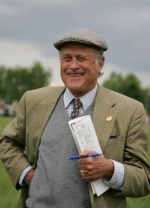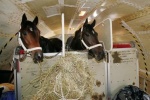California Horse Racing Board decision poses danger to all trainers
The racing industry has been taking a long look at ways to improve safety for horses and riders. In an attempt to reduce injuries, racing associations have spent millions of dollars on synthetic surfaces. Additional millions have been spent at UC Davis reviewing and analyzing injuries.But the search for safety may now have gone too far and it may be turning into a witch hunt. During the past few months, the CHRB has accused three trainers of violating CHRB regulation 1902.5:
Edward I. Halpern, CTT Exec (
08 April 2009 - Issue number 12)
No need for a rain dance in March after significantly wet February
The month of February has brought a significant amount of rain to Northern California. It is inconvenient, but this year it is sure needed. In years past, rain would have meant sealed racetracks, fortunately, that is no longer the case. That change came as a result of the Tapeta track at Golden Gate Fields.
Charles E. Dougherty, Jr. CTT Deputy Director
(08 April 2009 - I2)
Derby Fever for Gilchrist was Lost In The Fog
At
this time of the year when trainers and owners can sometimes be swept
up in an obsession to get a three-year-old with any glimmer of hope to
the Kentucky Derby, trainer Greg Gilchrist remains forever thankful that
he developed immunity to Derby Fever.Relaxing in his home in Castro
Valley in Northern California recently, the veteran conditioner cited
the 2005 tale of Lost in the Fog as a memorial to both the horse and his
owner, Harry Aleo.
Steve Schuelein
(08 April 2009 - Issue Number: 12)
Test of the Champion - a history of the Belmont Stakes
CLICK ON IMAGE TO READ ARTICLE
Bill Heller (08 April 2009 - Issue Number: 12)
Jonathan Sheppard - an interview with the champion trainer
Sean Clancy (20 January 2009 - Issue Number: 11)
Evening Attire - a firm favourite with fans
Bill Heller (20 January 2009 - Issue Number: 11)
Tendon Treatments - how to treat the common injury
Tendon damage is one of the most common and perplexing soft tissue injuries in racing jurisdictions throughout the world. Roughly eight to thirty percent of racehorses in the United States, eleven percent in Japan, five to fifty percent in the United Kingdom (including jump horses) and at least five percent in Australia sustain tendon injuries during their careers.
Kimberly French (20 January 2009 - Issue Number: 11)
Amino Acid Supplements - the important element of protein
Dr Catherine Dunnett (20 January 2009 - Issue Number: 11)
Oaklawn - the first Eclipse Award-winning racetrack
Last fall, ownership of the New York Yankees was passed from George Steinbrenner to his son Hank, ensuring the Steinbrenner stewardship of professional sports’ most prestigious franchise will continue after George's 35 years.That's a little more than a third as long as the Cella family's astute leadership of Oaklawn Park in Hot Springs, Arkansas.
Bill Heller (20 January 2009 ) Issue 11
Simplify Taxes? Keep a record of it!
Chris E. Wittstruck (20 January 2009 - Issue Number: 11)
Heart Monitors and Lactate Analysis - how they can help train horses
Eight
days after winning the longest and most grueling of the Triple Crown
races, the Belmont Stakes,Swale died of a heart attack. Was this great
champion pushing himself so far to the limit that his heart could not
cope?
James Tate BVMS MRCVS
(20 January 2009 - Issue 11)
Adrian Maguire: the ‘hands-on’ horseman
A brilliant and brave jockey, who had his fair share of misfortune with injuries – a broken neck forced him to retire from race riding – Adrian Maguire is now forging a successful career as a trainer and while laid back in personality, he has plenty to say about the state of racing in his home country.
Lissa Oliver (European Trainer - issue 24 - Winter 2008)
Amanda Perrett - following in her father's footsteps
Guy Harwood trained Dancing Brave, one of the all-time great racehorses. Ten years after the horse’s dramatic Prix de L’Arc de Triomphe victory Harwood handed over the reins of his Coombelands Stables to the eldest of his three daughters. What Amanda Perrett inherited in 1996 was not just a prestigious operation; it was one of the most innovative and best-equipped training establishments that Europe had ever seen.
Sean Magee (European Trainer - issue 24 - Winter 2008)
Stress and the Thoroughbred - a closer look at the loosely-used term
There can be few terms used as loosely by both practical horse people and animal scientists as the term ‘stress’.
Dr Mark Kennedy (European Trainer - issue 24 - Winter 2008)
The challenge of transport - the practical considerations for transporting horses
The after-effects of travel on racehorses has vexed trainers for decades. Short-distance transport of racehorses is, as every trainer knows, almost always of very little consequence. Longer distance transport presents a much greater challenge and months of work and planning can be undone in the course of a few hours.
Des Leadon (European Trainer - issue 24 - Winter 2008)
Italian racing goes on strike and brings Rome to a standstill
Alitalia lives to fly another day thanks to a combination of Italian Prime Minister Silvio Berlusconi’s business acumen, unshakable confidence, negotiation skills tuned finer than the engine of a Boeing 747, and utter persistence in the face of strong opposition from syndicate representatives well beyond the eleventh hour.
Niki Sweetnam (European Trainer - issue 24 - Winter 2008)
Amino Acid Supplements - the important element of protein
Horses in training are traditionally fed a diet that is high in protein, but it is the amino acid content of the protein-rich ingredients that is the important component.
Dr Catherine Dunnett (European Trainer - issue 24 - Winter 2008)
Picky Eaters - a common problem in horses in training
Poor appetite in horses in training is not uncommon, whether this is a transient problem following racing, or, more regularly, during training in particular horses.
Dr Catherine Dunnett (European Trainer - issue 24 - Winter 2008)















